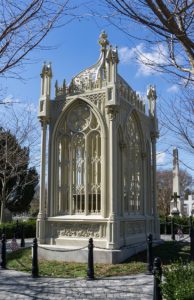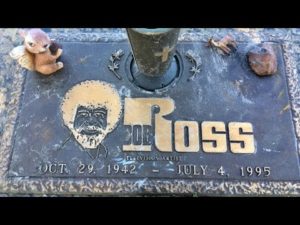
Portrait of Thomas Jefferson by Rembrandt Peale
On this day in 1826, the 50th anniversary of the Declaration of Independence and a few hours before the death of John Adams, polymath, planter, lawyer, teacher, one of the Founding Fathers of the United States, 2nd Governor of Virginia, United States Ambassador to France, 1st United States Secretary of State, 2nd Vice President of the United States, 3rd President of the United States, Thomas Jefferson died at his home Monticello just outside Charlottesville, Virginia at the age of 83. Born on 13 April 1743 in Shadwell, Colony of Virginia.
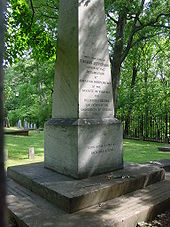 The Final Footprint – Jefferson is interred in the family cemetery at Monticello. His grave is marked by a large upright stone monument. Jefferson wrote his own epitaph, which reads:
The Final Footprint – Jefferson is interred in the family cemetery at Monticello. His grave is marked by a large upright stone monument. Jefferson wrote his own epitaph, which reads:
HERE WAS BURIED THOMAS JEFFERSON
AUTHOR OF THE DECLARATION OF AMERICAN INDEPENDENCE
OF THE STATUTE OF VIRGINIA FOR RELIGIOUS FREEDOM
AND FATHER OF THE UNIVERSITY OF VIRGINIA
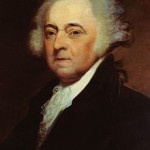 On this day in 1826, the 50th anniversary of the adoption of the Declaration of Independence, the 2nd president of the United States (1797–1801), the first vice president of the United States, an American Founding Father, statesman, diplomat, father of John Quincy Adams (the 6th President of the United States), John Adams died at his home in Quincy, Massachusetts at the age of 90. Born on 30 October 1735, in what is now Quincy, Massachusetts (then called the “north precinct” of Braintree, Massachusetts). A leading advocate of American independence from Great Britain. Well educated, he was an Enlightenment political theorist who promoted republicanism and wrote prolifically about his often seminal ideas, both in published works and in letters to his wife and key adviser Abigail Adams, as well as to other Founding Fathers. Adams came to prominence in the early stages of the American Revolution. A lawyer and public figure in Boston, as a delegate from Massachusetts to the Continental Congress, he played a leading role in persuading Congress to declare independence. He assisted Thomas Jefferson in drafting the Declaration of Independence in 1776, and was its primary advocate in the Congress. Later, as a diplomat in Europe, he helped negotiate the eventual peace treaty with Great Britain, and was responsible for obtaining vital governmental loans from Amsterdam bankers. A political theorist and historian, Adams largely wrote the Massachusetts Constitution in 1780, which together with his earlier Thoughts on Government, influenced American political thought. One of his greatest roles was as a judge of character: in 1775, he nominated George Washington to be commander-in-chief, and 25 years later nominated John Marshall to be Chief Justice of the United States.
On this day in 1826, the 50th anniversary of the adoption of the Declaration of Independence, the 2nd president of the United States (1797–1801), the first vice president of the United States, an American Founding Father, statesman, diplomat, father of John Quincy Adams (the 6th President of the United States), John Adams died at his home in Quincy, Massachusetts at the age of 90. Born on 30 October 1735, in what is now Quincy, Massachusetts (then called the “north precinct” of Braintree, Massachusetts). A leading advocate of American independence from Great Britain. Well educated, he was an Enlightenment political theorist who promoted republicanism and wrote prolifically about his often seminal ideas, both in published works and in letters to his wife and key adviser Abigail Adams, as well as to other Founding Fathers. Adams came to prominence in the early stages of the American Revolution. A lawyer and public figure in Boston, as a delegate from Massachusetts to the Continental Congress, he played a leading role in persuading Congress to declare independence. He assisted Thomas Jefferson in drafting the Declaration of Independence in 1776, and was its primary advocate in the Congress. Later, as a diplomat in Europe, he helped negotiate the eventual peace treaty with Great Britain, and was responsible for obtaining vital governmental loans from Amsterdam bankers. A political theorist and historian, Adams largely wrote the Massachusetts Constitution in 1780, which together with his earlier Thoughts on Government, influenced American political thought. One of his greatest roles was as a judge of character: in 1775, he nominated George Washington to be commander-in-chief, and 25 years later nominated John Marshall to be Chief Justice of the United States.
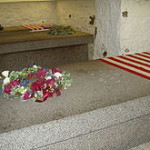 The Final Footprint – Told that it was the Fourth, he answered clearly, “It is a great day. It is a good day.” His last words have been reported as “Thomas Jefferson survives” (Jefferson himself, however, had died hours before Adams did). Adams is entombed at United First Parish Church (also known as the Church of the Presidents) in Quincy. Originally, he was buried in Hancock Cemetery, across the road from the Church.
The Final Footprint – Told that it was the Fourth, he answered clearly, “It is a great day. It is a good day.” His last words have been reported as “Thomas Jefferson survives” (Jefferson himself, however, had died hours before Adams did). Adams is entombed at United First Parish Church (also known as the Church of the Presidents) in Quincy. Originally, he was buried in Hancock Cemetery, across the road from the Church.
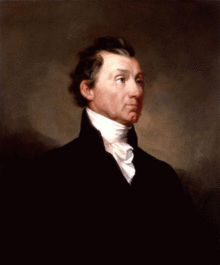 On this day in 1831, 12th and 16th Governor of Virginia, 7th United States Secretary of State, the fifth President of the United States (1817–1825), the last president who was a Founding Father of the United States, the third of them to die on Independence Day, and the last president from the Virginia dynasty and the Republican Generation, James Monroe died at his daughters home in New York City from heart failure and tuberculosis at the age of 73. Born on 28 April 1758, in his parents’ house located in a wooded area of Westmoreland County, Virginia. Monroe was of the planter class and fought in the American Revolutionary War. After studying law under Thomas Jefferson from 1780 to 1783, he served as a delegate in the Continental Congress. As an anti-federalist delegate to the Virginia convention that considered ratification of the United States Constitution, Monroe opposed ratification, claiming it gave too much power to the central government. He took an active part in the new government, and in 1790 he was elected to the Senate of the first United States Congress, where he joined the Jeffersonians. He gained experience as an executive as the Governor of Virginia and rose to national prominence as a diplomat in France, when he helped negotiate the Louisiana Purchase in 1803. During the War of 1812, Monroe held the critical roles of Secretary of State and the Secretary of War under President James Madison. Facing little opposition from the fractured Federalist Party, Monroe was easily elected president in 1816, winning over 80 percent of the electoral vote and becoming the last president during the First Party System era of American politics. As president, he bought Florida from Spain and sought to ease partisan tensions, embarking on a tour of the country that was generally well received. With the ratification of the Treaty of 1818, under the successful diplomacy of his Secretary of State John Quincy Adams, the United States extended from the Atlantic to the Pacific, giving America harbor and fishing rights in the Pacific Northwest. The landmark Treaty of 1819 secured the border of the United States along the 42nd Parallel to the Pacific Ocean and represented America’s first determined attempt at creating an “American global empire”. As nationalism surged, partisan fury subsided and the “Era of Good Feelings” ensued until the Panic of 1819 struck and dispute over the admission of Missouri embroiled the country in 1820. Nonetheless, Monroe won near-unanimous reelection. In 1823, he announced the United States’ opposition to any European intervention in the recently independent countries of the Americas with the Monroe Doctrine, which became a landmark in American foreign policy. His presidency concluded the first period of American presidential history before the beginning of Jacksonian democracy and the Second Party System era.
On this day in 1831, 12th and 16th Governor of Virginia, 7th United States Secretary of State, the fifth President of the United States (1817–1825), the last president who was a Founding Father of the United States, the third of them to die on Independence Day, and the last president from the Virginia dynasty and the Republican Generation, James Monroe died at his daughters home in New York City from heart failure and tuberculosis at the age of 73. Born on 28 April 1758, in his parents’ house located in a wooded area of Westmoreland County, Virginia. Monroe was of the planter class and fought in the American Revolutionary War. After studying law under Thomas Jefferson from 1780 to 1783, he served as a delegate in the Continental Congress. As an anti-federalist delegate to the Virginia convention that considered ratification of the United States Constitution, Monroe opposed ratification, claiming it gave too much power to the central government. He took an active part in the new government, and in 1790 he was elected to the Senate of the first United States Congress, where he joined the Jeffersonians. He gained experience as an executive as the Governor of Virginia and rose to national prominence as a diplomat in France, when he helped negotiate the Louisiana Purchase in 1803. During the War of 1812, Monroe held the critical roles of Secretary of State and the Secretary of War under President James Madison. Facing little opposition from the fractured Federalist Party, Monroe was easily elected president in 1816, winning over 80 percent of the electoral vote and becoming the last president during the First Party System era of American politics. As president, he bought Florida from Spain and sought to ease partisan tensions, embarking on a tour of the country that was generally well received. With the ratification of the Treaty of 1818, under the successful diplomacy of his Secretary of State John Quincy Adams, the United States extended from the Atlantic to the Pacific, giving America harbor and fishing rights in the Pacific Northwest. The landmark Treaty of 1819 secured the border of the United States along the 42nd Parallel to the Pacific Ocean and represented America’s first determined attempt at creating an “American global empire”. As nationalism surged, partisan fury subsided and the “Era of Good Feelings” ensued until the Panic of 1819 struck and dispute over the admission of Missouri embroiled the country in 1820. Nonetheless, Monroe won near-unanimous reelection. In 1823, he announced the United States’ opposition to any European intervention in the recently independent countries of the Americas with the Monroe Doctrine, which became a landmark in American foreign policy. His presidency concluded the first period of American presidential history before the beginning of Jacksonian democracy and the Second Party System era.
The Final Footprint – Monroe was originally entombed in New York at the Gouverneur family’s vault in the New York City Marble Cemetery. Twenty-seven years later in 1858 the body was re-entombed to the President’s Circle at the Hollywood Cemetery in Richmond, Virginia. The James Monroe Tomb is a U.S. National Historic Landmark.
#RIP #OTD in 1938, tennis player, 8x singles Grand Slam champ (Wimbledon 6x, Roland-Garros 2x), Suzanne Lenglen died in Paris aged 39. Cimetière de Saint-Ouen just outside Paris
#RIP #OTD in 1990 writer (Cold Sassy Tree) Olive Ann Burns died of heart failure in Atlanta, aged 65. Grey Hill Cemetery, Commerce, Georgia.
#RIP #OTD in 1995 actress (The Aristocats, The Rescuers, Green Acres), businesswoman, singer, socialite, sister of Zsa Zsa and Magda, Eva Gabor died in Los Angeles from respiratory failure and pneumonia, aged 76. Westwood Memorial Park, Westwood, California
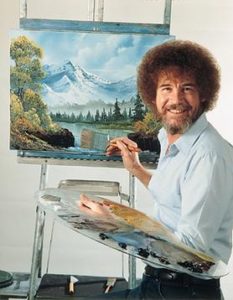 On this day in 1995, United States Air Force veteran, painter, art instructor, and television host Bob Ross died from lymphoma at the age of 52. Born Robert Norman Ross on October 29, 1942 in Daytona Beach, Florida. He was the creator and host of The Joy of Painting, an instructional television program that aired from 1983 to 1994 on PBS in the United States, Canada, Latin America, and Europe. Ross went from being a public television personality in the 1980s and 1990s to being an Internet celebrity in the 21st century, becoming popular with fans on YouTube and many other websites many years after his death.
On this day in 1995, United States Air Force veteran, painter, art instructor, and television host Bob Ross died from lymphoma at the age of 52. Born Robert Norman Ross on October 29, 1942 in Daytona Beach, Florida. He was the creator and host of The Joy of Painting, an instructional television program that aired from 1983 to 1994 on PBS in the United States, Canada, Latin America, and Europe. Ross went from being a public television personality in the 1980s and 1990s to being an Internet celebrity in the 21st century, becoming popular with fans on YouTube and many other websites many years after his death.
Ross was married three times; Vivian Ridge (1965-1977 divorce), Jane Ross (1977-1992 her death), and Lynda Brown (1995-1995 his death).
The Final Footprint
His remains are interred at Woodlawn Memorial Park in Gotha, Florida. The grave is marked by a individual bronze on granite marker.
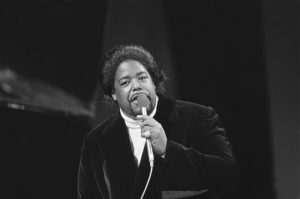 On this day in 2003, singer-songwriter, musician, record producer and composer Barry White died at Cedars-Sinai Medical Center in Los Angeles at the age of 58. Born Barry Eugene Carter on September 12, 1944 in Galveston, Texas. A three-time Grammy Award–winner known for his distinctive bass-baritone voice and romantic image, his greatest success came in the 1970s as a solo singer and with The Love Unlimited Orchestra, crafting many enduring soul, funk, and disco songs such as his two biggest hits: “You’re the First, the Last, My Everything” and “Can’t Get Enough of Your Love, Babe”. During the course of his career in the music business, White achieved 106 gold albums worldwide, 41 of which also attained platinum status. White had 20 gold and 10 platinum singles.
On this day in 2003, singer-songwriter, musician, record producer and composer Barry White died at Cedars-Sinai Medical Center in Los Angeles at the age of 58. Born Barry Eugene Carter on September 12, 1944 in Galveston, Texas. A three-time Grammy Award–winner known for his distinctive bass-baritone voice and romantic image, his greatest success came in the 1970s as a solo singer and with The Love Unlimited Orchestra, crafting many enduring soul, funk, and disco songs such as his two biggest hits: “You’re the First, the Last, My Everything” and “Can’t Get Enough of Your Love, Babe”. During the course of his career in the music business, White achieved 106 gold albums worldwide, 41 of which also attained platinum status. White had 20 gold and 10 platinum singles.
White married his childhood sweetheart Mary, but the couple separated in 1969 and later divorced. In 1974, White married singer Glodean James.
The Final Footprint
His remains were cremated, and the ashes were scattered in the ocean off the California coast.
Have you planned yours yet?
Follow TFF on twitter @RIPTFF

